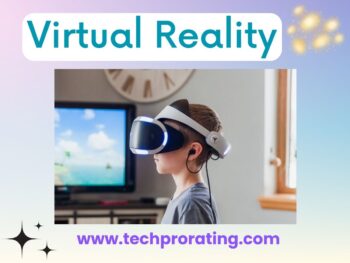Virtual reality has come a long way since the first head-mounted display was invented in 1968 by Ivan Sutherland. Over the past few decades, the technology has evolved significantly and is now capable of delivering immersive experiences that were once unimaginable. From gaming to healthcare, education, and beyond, virtual reality has become the next frontier in technology.
In this blog post, we’ll explore the world of virtual reality, its potential uses, and its impact on our daily lives.
What Is Virtual Reality?
Virtual reality (VR) is a technology that allows users to experience a simulated environment that feels real. Using a head-mounted display (HMD) and hand-held controllers, users can interact with a computer-generated world and feel like they are physically present within it.
VR works by simulating the user’s senses, such as sight, hearing, and touch, and delivering them to the brain through the HMD and controllers. By tracking the user’s movements and adjusting the virtual environment accordingly, VR creates a convincing and immersive experience that can transport users to places they’ve never been before.
Potential Uses of Virtual Reality
Gaming
One of the most well-known uses of VR is in gaming. VR technology has opened up new possibilities for immersive gaming experiences, allowing players to feel like they are inside the game world. From shooting games to puzzle games and everything in between, VR has given gamers a whole new way to experience their favorite pastime.
Education
Virtual reality is also being used in education, allowing students to experience historical events or explore distant locations that would otherwise be impossible. From virtual field trips to immersive language learning, VR is transforming the way we learn and absorb information.
Healthcare
In the healthcare industry, virtual reality is being used to treat conditions such as post-traumatic stress disorder (PTSD) and chronic pain. By creating a virtual environment that replicates a patient’s traumatic experience or distracting them from their pain, VR is providing a new and effective way to treat patients.
Tourism
Virtual reality is also transforming the tourism industry. By creating virtual tours of popular tourist destinations, VR is allowing people to experience new places and cultures without leaving their homes. This has opened up new opportunities for travel companies, allowing them to showcase their destinations in a way that was once impossible.
Impact on Daily Life
The potential uses of virtual reality are numerous and varied, and as the technology continues to evolve, we are likely to see even more applications in the coming years. But what impact will VR have on our daily lives?
One of the biggest impacts of VR is the way it is changing the way we interact with technology. With VR, we are no longer limited to a flat screen or mouse and keyboard. Instead, we can use our natural movements to interact with the virtual world, creating a more intuitive and immersive experience.
VR is also creating new opportunities for social interaction. With virtual reality social platforms, people can connect with others from around the world in a shared virtual environment. This has the potential to create new communities and foster greater social connections.
But as with any new technology, there are also concerns about the impact of VR on our daily lives. One concern is that virtual reality could lead to a further disconnect from the real world, as people spend more time in simulated environments. There is also the risk of addiction, as people become increasingly immersed in virtual experiences.
The Future of Virtual Reality
Despite the potential drawbacks, virtual reality is a technology with a bright future. As the technology continues to evolve, we are likely to see even more applications for VR, from entertainment to education, healthcare, and beyond.
One of the biggest advancements in VR is the move towards standalone devices, which do not require a computer or console to run. This will make VR more accessible to a wider audience and











